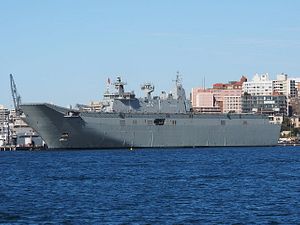HMAS Canberra is on her way to Fiji.
Canberra is headed to Fiji in the wake of Cyclone Winston, which has reportedly killed dozens, done tremendous property and infrastructure damage, and left up to 30,000 homeless. The United Nations has suggested that Winston is the most devastating cyclone ever to hit the island.
Canberra is reportedly carrying 800 relief personnel, along with sixty tons of relief equipment. The Royal Australian Air Force has already begun relief operations, and elements of the Royal New Zealand Navy have joined Canberra in the assistance mission.
The 27,500-ton amphibious assault ship, constructed in Spain and Australia, entered service in late 2014. She and her sister can, in expeditionary combat configuration, carry over a hundred vehicles. In air support configuration, they can carry eighteen helicopters (8 is standard capacity). The well deck allows the rapid deployment of vehicles and personnel from ship to shore, especially in areas where docking structures have been damaged or destroyed. Canberra can remain on station for an extended period, especially when acting in conjunction with air and other sea assets.
Relief of Fiji is precisely the kind of operation that Australia envisioned for Canberra and her sister. The potential to operate F-35B Joint Strike Fighters notwithstanding, the value of the Canberra-class lies primarily in its ability to conduct humanitarian assistance/disaster relief (HADR) “influence” operations, demonstrating Australia’s commitment to regional stability and well-being.
Maritime Southeast Asia (not to mention Oceania) is characterized by wide spaces, meager-to-non-existent infrastructure, low state capacity, and irregular severe weather. Because of this, humanitarian and disaster relief needs are generally underserved. The Canberra-class (and other, similar ships in other navies) fills this gap by offering platforms for air and sea relief, as well as medical care and infrastructure repair. Over the past decade, navies around the world have “chased” the HADR mission by building flat-decked amphibs capable of operational support off disaster-stricken coasts.
This is because the deployment of Canberra fulfills a political purpose, underlining the central role that Australia (and the Royal Australian Navy) plays in regional politics and security affairs. Canberra allows Australia to lead such operations, serving as the focal point for international efforts. In the past, the United States has generally played this role, using its large, flat-decked amphibs in disaster areas such as Haiti, Japan, and Indonesia. The proliferation of amphibs means that more navies are getting into this game, an arms race with the unlikely consequence of improving the prospects of displaced person in disaster-stricken areas.

































